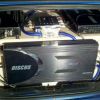I understand exactly where you are coming from but there are some gives and takes on it. The main reason we picked birch was because of how strong vs. how light it is. since most of the wood is done in short distances (and looks prettier than MDF) we used a layer of birch instead of an additional layer of MDF on the second layer of the shell. We have comp boxes that weigh the lightest (like mine) around 300 lbs, and heavy ones (in our extreme) that weight just north of 2,800lbs The birch shaved off about 80/90 lbs that didn't affect the integrity.
The steel is great to stop flexing - it helps reinforce the boxes at the joints (Especially the port wall). But they key is not to leave the steel open in the box. The Angles are sealed and tapped then glossed over (So you can still remove the baffle when all said and done.)
Now I will agree that Primer has a better acoustic value sound, it does allows a wider band of reverb at a lower gain (In our testing). But the Resin has a lower band of reverb at a higher gain. So a primer'd box sounds great usually especially when the tuning hits a higher frequency range. The Resin is stronger, extremely smooth if you do it right, and allows pitches to reverb better. The issue is when you resin a box your peak frequency is like 51 or 52. with our primer'd boxes you can get away with 50 - 54 hz. This difference has equated to around a .3 db difference, but we all know there could be a large amount of factors for that. As much as a pain as resin is, the smoothness and physical strength it provides is better than any other material I have used to-date.
I never run subs out of phase if I can avoid itAnd again it sounds like you have done more Sound Quality competitions, I am in Sound Pressure - so loudest (Ugly or not) sound wins! I have attempted, but I just did not like keeping up with RTA scores in such, I just preferred the bigger projects then the fine tuning ones.



 LinkBack URL
LinkBack URL About LinkBacks
About LinkBacks

 LeLu
LeLu Lelu
Lelu
 Reply With Quote
Reply With Quote